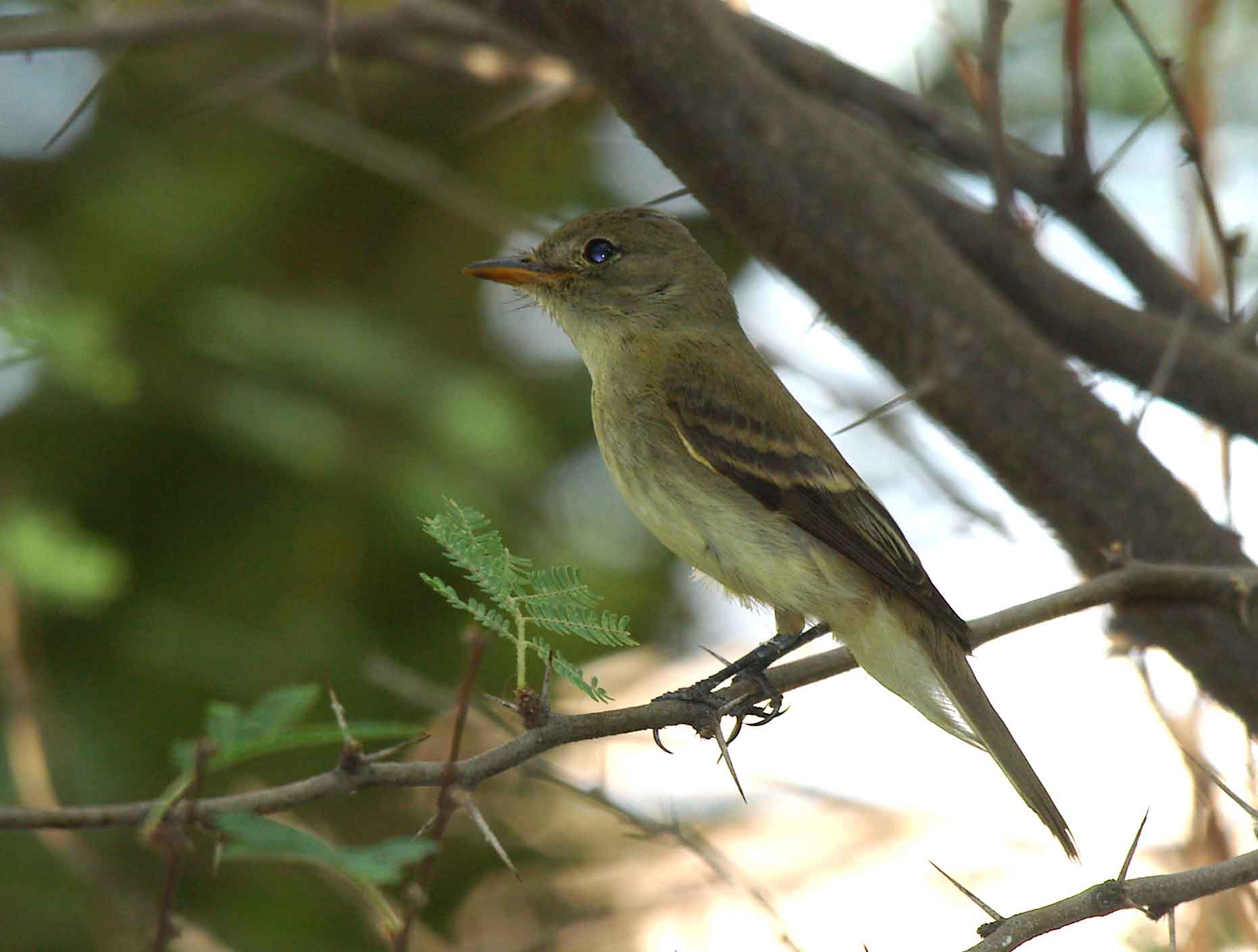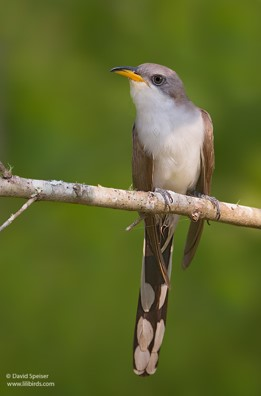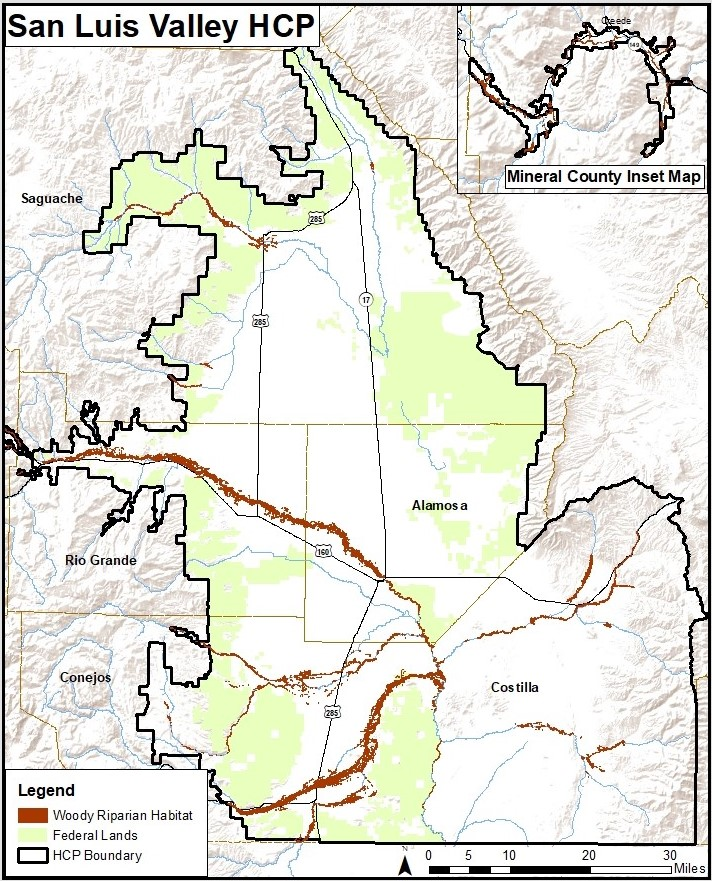Habitat Conservation Plan

Click here to join the HCP mailing list! You will receive HCP newsletters, meeting updates, events, program developments, and more.
Introduction
The San Luis Valley’s riparian communities along the Rio Grande, Conejos River, and smaller tributaries are home to the southwestern willow flycatcher (flycatcher) (Empidonax traillii extimus) and the western yellow-billed cuckoo (cuckoo) (Coccyzus americanus). The flycatcher is a federally listed endangered species in addition to being listed as endangered by the state of Colorado; and the western distinct population segment of cuckoo is listed as threatened under the Endangered Species Act (ERO Resource Corporation, 2011a). In 2012, the San Luis Valley Regional Habitat Conservation Plan was finalized to prevent critical habitat designation throughout the valley, ensuring the continuation of historically routine activities that are critical to the valley's economy and lifeblood.
Southwestern Willow Flycatcher

The southwestern willow flycatcher is a small bird less than 6 inches in length from the tip of their bill to the tip of their tail. Overall, the body is a brownish-olive to gray-green, with conspicuous light-colored wing bars. The throat is whitish, the breast a pale olive color, and the belly yellowish. The bill is large relative to its body, and the lower mandible is completely pale. They lack the pale eye-ring of many similar Empidonax species. These birds are difficult to distinguish by sight, and best identified by their vocalizations. Their call is a liquid, sharply whistled whit! or a dry sprrit; while their song is a sneezy witch-pew or fitz-bew (U.S. Fish and Wildlife Service, 2011).
With the efficiency of their large, flat bill, flycatchers are known as the “master of gnats” and help to control insect populations around wetlands and waterways. They are insectivores and feed on a variety of insects such as wasps, bees, flies, beetles, butterflies, moths, and caterpillars.
Flycatchers overwinter in the tropics and come north to breed in early May-June. They generally breed in tall dense riparian habitat with low gradient streams, wetlands, or saturated soils nearby.
Yellow-Billed Cuckoo

The western yellow-billed cuckoo's size is about 30 cm (12 in) in length, or slightly larger than a robin. Their color is brownish above with a white neck and belly and rusty colored flight feathers. The bird’s large, distinguishing curved bill is yellow on the lower mandible and black on the upper mandible. The underside of the tail has three pairs of large white spots, which can also be used as an identifying feature (U.S. Fish and Wildlife Service, 2011). This species is elusive, and difficult to detect by sight. The best way to detect one is to listen for their loud “Kowlp” call.
The yellow-billed cuckoo’s diet mainly consists of large insects; such as caterpillars, cicadas, grasshoppers, and other crop destroying insects. They are also known to eat small lizards, frogs, eggs, and occasionally young birds (Seattle Audubon Society, 2008).
Cuckoos have a very rapid breeding cycle and typically arrive in early to mid-June from their wintering grounds in South America. Their breeding cycle usually depends on abundant food supply that may coincide with an outbreak of caterpillars or cicadas. Once they arrive, males and females work together to build stick nests lined with bark and leaves. The cuckoo nests in a variety of habitats such as open woodlands, parks and riparian woodlands. The western population of cuckoo is more restricted to cottonwood and willow woodlands with a dense understory and large blocks of riparian habitat. The average time from egg laying to fledging, or when wing feathers are developed enough for flight, is 17 days (National Park Service, 2014).
San Luis Valley Regional Habitat Conservation Plan

Any activities that impact listed species or their habitat (defined as "take") are subject to regulation under the Endangered Species Act (ESA) and other federal laws. An HCP is a community-
based plan to conserve endangered species habitat while allowing private land use and management to continue. Without a regional HCP, individual landowners could be regulated under the ESA on a case-by-case basis, which could be both costly and time consuming. A completed HCP is necessary to receive an Incidental Take Permit (ITP), which authorizes impacts to ESA listed species, provided certain conditions and assurances are met- like impact mitigation. The purpose of the San Luis Valley Regional Habitat Conservation Plan (HCP) is to provide for the long-term conservation of the southwestern willow flycatcher and yellow-billed cuckoo while providing regulatory protection for activities that are critical to the social and economic well-being of the Valley. The District initiated the habitat conservation plan (HCP) process in 2004 in a partnership with the State of Colorado and all six counties of the San Luis Valley: Alamosa, Conejos, Costilla, Mineral, Rio Grande, Saguache. The San Luis Valley Habitat Conservation Plan has been in effect since 2012.
Click Here to view the final HCP.The HCP provides regulatory protection across all non-federal lands of the San Luis Valley floor for certain typical and routine activities related to routine agriculture, small community infrastructure, and riparian conservation and restoration. Impacts may be temporary (cutting, trampling, or removing riparian vegetation for a short time (not exceeding one growing season)) which allow vegetation to regenerate, or permanent removal of vegetation (coverage is limited up to 0.5 acres of permanent impacts per project). Covered Activities include:

The HCP does not provide regulatory protection to land development, large-scale water projects or impoundments, highway construction, energy development, or activities with a federal nexus. Please contact your county land use department or the HCP coordinator before beginning your project if you are unsure of your coverage.
HCP Mitigation Program
To meet the requirements of the ESA ITPs, the RGWCD must ensure that habitat impacts from the above covered activities occurring throughout the valley are offset. Landowners with flycatcher and cuckoo habitat, typically already under deeded conservation easements, can voluntarily enroll their property in the HCP Mitigation Program. This voluntary enrollment does not require any additional work for the landowner; just preserve the existing habitat! Landowners also have the option to unenroll their property at any time. If you are interested in enrolling your property, please fill out this Google form.
Private landowner involvement in the HCP Mitigation Program is crucial to it's continued success.
How Can I Help?
- Educate yourself and others about the HCP- ask questions!
- Limit overall impacts to wetland and riparian habitat
- Avoid habitat impacts during the breeding season, which occurs May-August
- Consult with the HCP Coordinator or your local Land Use Administrator before beginning projects
- Contact us to enroll your property in the HCP Mitigation Program!
Check out our annual newsletter for brief year-end updates on all things HCP. New issues will be posted here.
Issue No. 3 - 2022Issue No. 2 - 2021Issue No. 1 - 2020The HCP Steering Committee meets in April and November of each year. These meetings are open to the public. Click here to be redirected to the RGWCD calendar to view our next scheduled meeting.
Steering Committee Inception Documents:
CharterBylawsNovember 2014 Steering Committee Meeting MinutesApril 2014 Steering Committee Meeting MinutesMarch 2014 Biologist Sub-Committee Meeting MinutesNovember 2013 Steering Committee Meeting MinutesJune 2013 Steering Committee Meeting MinutesMarch 2013 Steering Committee Kick-off Meeting Minutes